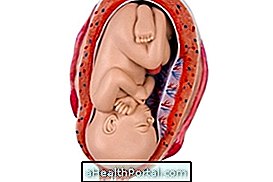Chronic pericarditis is an inflammation of the double membrane surrounding the heart called the pericardium. It is caused by fluid accumulation or increased tissue thickness, which may alter the functioning of the heart.
Pericarditis has a slow and gradual evolution and may persist for a long time without symptoms being noticed. Chronic pericarditis can be classified as:
- Constrictive : it is less frequent and appears when a scar tissue is developed around the heart, which may cause thickening and calcification of the pericardium;
- With stroke : the fluid accumulation in the pericardium happens quite slowly. If the heart is functioning normally, the doctor usually accompanies without major interventions;
- Effusive : usually caused by advanced kidney disease, malignant tumors and chest trauma.
The treatment of chronic pericarditis varies according to the cause and is usually the treatment done with the aim of relieving the symptoms.

Main symptoms
Chronic pericarditis is most often asymptomatic, however there may be some symptoms such as chest pain, fever, difficulty breathing, coughing, tiredness, weakness and pain when breathing. See also other causes of chest pain.
Possible Causes of Chronic Pericarditis
Chronic pericarditis can be caused by several situations, the most common being:
- Infections caused by viruses, bacteria or fungi;
- After radiation therapy for breast cancer or lymphoma;
- Heart attack;
- Hypothyroidism;
- Autoimmune diseases such as systemic lupus erythematosus;
- Renal insufficiency;
- Trauma in the thorax;
- Surgeries in the heart.
In less developed countries, tuberculosis is still the most frequent cause of pericarditis in any of its types, but is rare in richer countries.
How is the diagnosis made?
The diagnosis of chronic pericarditis is made by the cardiologist through physical examination and imaging, such as the chest x-ray, magnetic resonance imaging and computed tomography. In addition, the doctor can perform the electrocardiogram to evaluate the functioning of the heart. Understand how the electrocardiogram is done.
The cardiologist should also consider at the time of diagnosis the presence of any other condition that interferes with the performance of the heart.
How to treat
The treatment for chronic pericarditis is done according to the symptoms, complications and whether the cause is known or not. When the cause of the disease is known, the treatment established by the cardiologist is directed, avoiding the progression of the disease and possible complications.
In most cases of chronic pericarditis, the treatment indicated by the cardiologist is with the use of diuretic medications, which help in the elimination of excess fluid from the body. It is important to emphasize that the use of diuretic drugs is done with the objective of relieving the symptoms, and the definitive treatment is the surgical removal of the pericardium in order to reach the cure completely. Learn how pericarditis is treated.




















